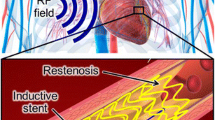Abstract
This paper presents the in situ and ex vivo evaluation of a system that wirelessly monitors the accumulation of intimal tissue and sludge in a biliary stent. The sensing element, located within the stent, is a magnetoelastic resonator that is queried by a wireless radio frequency signal. The in situ testing uses a commercially-available self-expanding biliary stent enhanced with a 1 mm × 25 mm magnetoelastic ribbon sensor (formed from Metglas™ 2605SA1). The stent has a conformal magnetic layer (consisting of strontium ferrite particles suspended in polydimethylsiloxane) that biases the sensor. The external interrogation module is able to acquire a signal from the sensor from a distance of at least 5 cm while the sensor is implanted in a porcine carcass and loaded with biological fluids. The ex vivo testing uses bile harvested from the porcine carcass. The response of a 1 mm × 25 mm magnetoelastic ribbon sensor is first calibrated with fluids of known density and viscosity, and the calibrated sensor is used to estimate that the viscosity of the harvested bile is 2.7–3.7 cP. The test results presented in this paper illustrate the fundamental usability of the system when the sensor is implanted, loaded by biological fluids, and interrogated in a surgical setup.










Similar content being viewed by others
Notes
All surgical procedures in this experiment were performed by R. Kwon.
References
ASM Handbook, vol. 16, (ASM International, 1989)
A. Colas, J. Curtis, in Biomaterials Science: An Introduction to Materials in Medicine, ed. by B. Ratner, A. Hoffman, F. Schoen, J. Lemons, 2nd edn. (Elsevier Academic, London, 2004), p. 80
C. Darvennes, S. Pardue, Boundary effect of a viscous fluid on a longitudinally vibrating bar: theory and application. J. Acoust. Soc. Am. 110(1), 216–224 (2001)
G. Donelli, E. Guaglianone, R. Di Rosa, F. Fiocca, A. Basoli, Plastic biliary stent occlusion: factors involved and possible preventive approaches. Clin. Med. Res. 5(1), 53–60 (2007)
G. Engdahl (ed.), Handbook of Giant Magnetostrictive Materials (Academic, London, 2000), pp. 1–19
S. Green, Y.B. Gianchandani, Wireless magnetoelastic monitoring of biliary stents. J. Microelectromech. Syst. 18(1), 64–78 (2009)
S. Green, Y.B. Gianchandani, Tailored magnetoelastic sensor geometry for advanced functionality in wireless biliary stent monitoring systems. J. Micromech. Microeng. (2010), in review
D. Jungst, A. Niemeyer, I. Muller, B. Zundt, G. Meyer, M. Wilhelmi, R. del Pozo, Mucin and phospholipids determine the viscosity of gallbladder bile in patients with gallstones. World J. Gastroenterol. 7(2), 203–207 (2001)
R. Kozarek, Metallic biliary stents for malignant obstructive jaundice: a review. World J. Gastroenterol. 6(5), 643–646 (2000)
L. Lagorce, M. Allen, Magnetic and mechanical properties of micromachined strontium ferrite/polyimide composites. J. Microelectromech. Syst. 6(4), 307–312 (1997)
D. Nelson, Expandable metal stents: physical properties and tissue responses. Tech. Gastrointest. Endosc. 3(2), 70–74 (2001)
J. Sung, Bacterial biofilm and clogging of biliary stents. J. Ind. Microbiol. 15, 152–155 (1995)
Acknowledgements
Metglas Inc., Hoosier Magnetics, and Dow Corning provided samples for this project. This work was supported in part by a National Science Foundation (NSF) Graduate Research Fellowship to S. Green, the NSF ERC for Wireless Integrated Microsystems (WIMS), and the University of Michigan.
Author information
Authors and Affiliations
Corresponding author
Rights and permissions
About this article
Cite this article
Green, S.R., Kwon, R.S., Elta, G.H. et al. In situ and ex vivo evaluation of a wireless magnetoelastic biliary stent monitoring system. Biomed Microdevices 12, 477–484 (2010). https://doi.org/10.1007/s10544-010-9404-7
Published:
Issue Date:
DOI: https://doi.org/10.1007/s10544-010-9404-7




